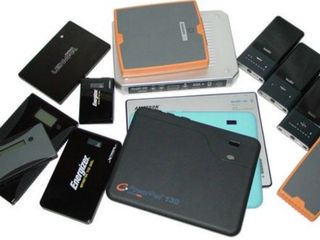New Nanostructure Technology Can Mean Longer Battery Life
Stanford researchers may have found the solution to making lithium-ion batteries last longer
Lithi

um-ion battery technology has made it so that portable devices can be used for a good portion of a day before needing more juice. Even then, I find myself wanting more. Maybe it’s because I’ve been spoiled by my iPad’s amazing battery life, but I wish that both my smartphone and my laptop could hold at least half a day’s worth of charge without me having to shut off absolutely every useful function on either electronic.
It looks like my hopes and dreams for my electronics might be fulfilled in the near future.
A team of Stanford researchers have found the solution to make lithium-ion batteries hold ten times the charge they currently can. How? By replacing the battery’s anode, usually constructed out of graphite, with silicon. It sounds like a simple fix, but scientists haven't been able to do so until now because the silicon would be quickly destroyed in a process called decrepitation. Even though silicon atoms would allow more lithium ions to bind than carbon atoms, therefore allowing the battery to store more charge, the silicon would expand and retract as ions flowed through the battery. These expansions and retractions caused cracks in the silicon. Another problem is that the lithium ions would sometimes react with the silicon, removing the battery’s ability to charge.
The Stanford team has developed a technique to strengthen the silicon anodes by making them out of nanowires and hollow nanoparticles. The anode is also coated with an outer layer of silicon oxide, a ceramic material that prevents the silicon from expanding.
For now, these batteries are able to operate for more than 6,000 cycles, well beyond current lithium-ion battery cycle life standards.
The team’s given no timetable for when this technology will be commercialized. For now, they’re working on simplifying the process of creating the new silicon anodes and creating better cathodes to match the new silicon anodes on lithium-ion batteries. I can only hope that such technology will trickle down to the consumer level soon.
Stay on the Cutting Edge
Join the experts who read Tom's Hardware for the inside track on enthusiast PC tech news — and have for over 25 years. We'll send breaking news and in-depth reviews of CPUs, GPUs, AI, maker hardware and more straight to your inbox.
-
downsb As amazing as this is, I wonder about more than just consumer electronics...what about automotive applications? Could this be the holy grail that allows EVs to surpass traditional gasoline cars in terms of demand? If I could drive back and forth to work for a week on a single charge as compared to a single tank of gas I'd be more than happy to jump on that wagon!Reply -
Chainzsaw Can't wait for the day when you can have a desktop replacement laptop that runs purely on solar power as well as indoor lightning. Of course have a small battery with it as well.Reply -
segio526 downsbAs amazing as this is, I wonder about more than just consumer electronics...what about automotive applications? Could this be the holy grail that allows EVs to surpass traditional gasoline cars in terms of demand? If I could drive back and forth to work for a week on a single charge as compared to a single tank of gas I'd be more than happy to jump on that wagon!Everything staying the same, these batteries would also take 10x more time to charge. If they can charge and discharge faster than current batteries, we'll be seeing these things in more applications. For example, they could displace lead acid batteries in cars and UPSes if they can discharge faster.Reply -
BulkZerker ChainzsawCan't wait for the day when you can have a desktop replacement laptop that runs purely on solar power as well as indoor lightning. Of course have a small battery with it as well.Reply
What your wanting has more to do with solar cell efficiency, not battery capacity. A netbook needs around 30 watts to run, so unless you have as solar cell producing at least 28 watts the battery is going to need a substantial battery to keep the device running. -
azgard segio526Everything staying the same, these batteries would also take 10x more time to charge. If they can charge and discharge faster than current batteries, we'll be seeing these things in more applications. For example, they could displace lead acid batteries in cars and UPSes if they can discharge faster.Reply
That we would have to see, lead acid batteries have been around so long because they are extremely durable, relatively cheap, and easily recycled(almost a 100% rate), not that I wouldn't like to see it, but outside of limited cases where cost is irrelevant and performance is important it will be hard to replace them. -
digitalgriffin Welcome to six years ago. Berkely had made similar announcements about the potential of silicon in batteries. However they have made no real advancements towards production. This is just another paper of little advancement trying to spur another round of funding.Reply -
digitalgriffin ChainzsawCan't wait for the day when you can have a desktop replacement laptop that runs purely on solar power as well as indoor lightning. Of course have a small battery with it as well.Reply
LMAO. That day will be never. Assuming your light source was 100% efficient (no energy wasted as heat. It all went to light) and your collection source could collect ALL that light (absolutely impossible), you would at best collect about 13 Watts. It takes 13 Watts to run an Atom processor alone.
-
A Bad Day Brb, patenting this new battery type and then suing every company that pushes such batteries into the consumer market.Reply
Most Popular


